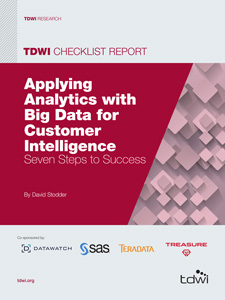
July 15, 2014
Customers do not conform to one data type, one channel, or one-size-
fits-all styles of marketing. Customers are empowered. Unhappy
customers will go to a competitor—and as social influencers, they will
take potential customers with them. Organizations cannot afford to be
complacent about how well they know their customers. Competitors
who are adept at quickly turning data and information into knowledge
will have a leg up in the race to attract and retain their customers.
Leading organizations are tapping both traditional and newer “big
data” resources to run advanced analytics programs to discover
trends, patterns, and other insights. These can fuel new products and
services or guide more efficient and effective operations. Although the
term big data is often defined inconsistently, it generally refers to new
sources of non-transactional, semi-structured, or unstructured data
that includes Web clickstreams and logs, machine data, location data,
and text. These sources have the potential to deliver what transaction
data alone cannot: contextual insights drawn from behavior across
channels. These sources help organizations understand and anticipate
what behavior leads to a purchase, what types of engagement will
keep customers loyal, and how customers influence each other in
social networks.
Big data is not exclusive to large organizations. Even small to
midsize organizations are confronted with more data volume, variety,
and velocity than they can handle with traditional systems. In
response, many enterprises today are expanding their customer data
architectures to include cloud data services, Hadoop, pre-configured
analytic appliances, and data virtualization.
Advanced analytics is essential for deriving maximum value from
customer data. Advanced analytics methods and technologies include
predictive analytics, statistics, data mining, machine learning,
and natural language processing. They enable users to get beyond
standard business intelligence (BI) or online analytical processing
(OLAP) querying and reporting to explore data for patterns, trends, and
correlations. Big data analytics is about applying advanced methods
and technologies to derive insights from very large and diverse data
sets that often include varied data types and streaming data.
This TDWI Checklist Report discusses steps for realizing value from big
data and analytics for better customer intelligence.